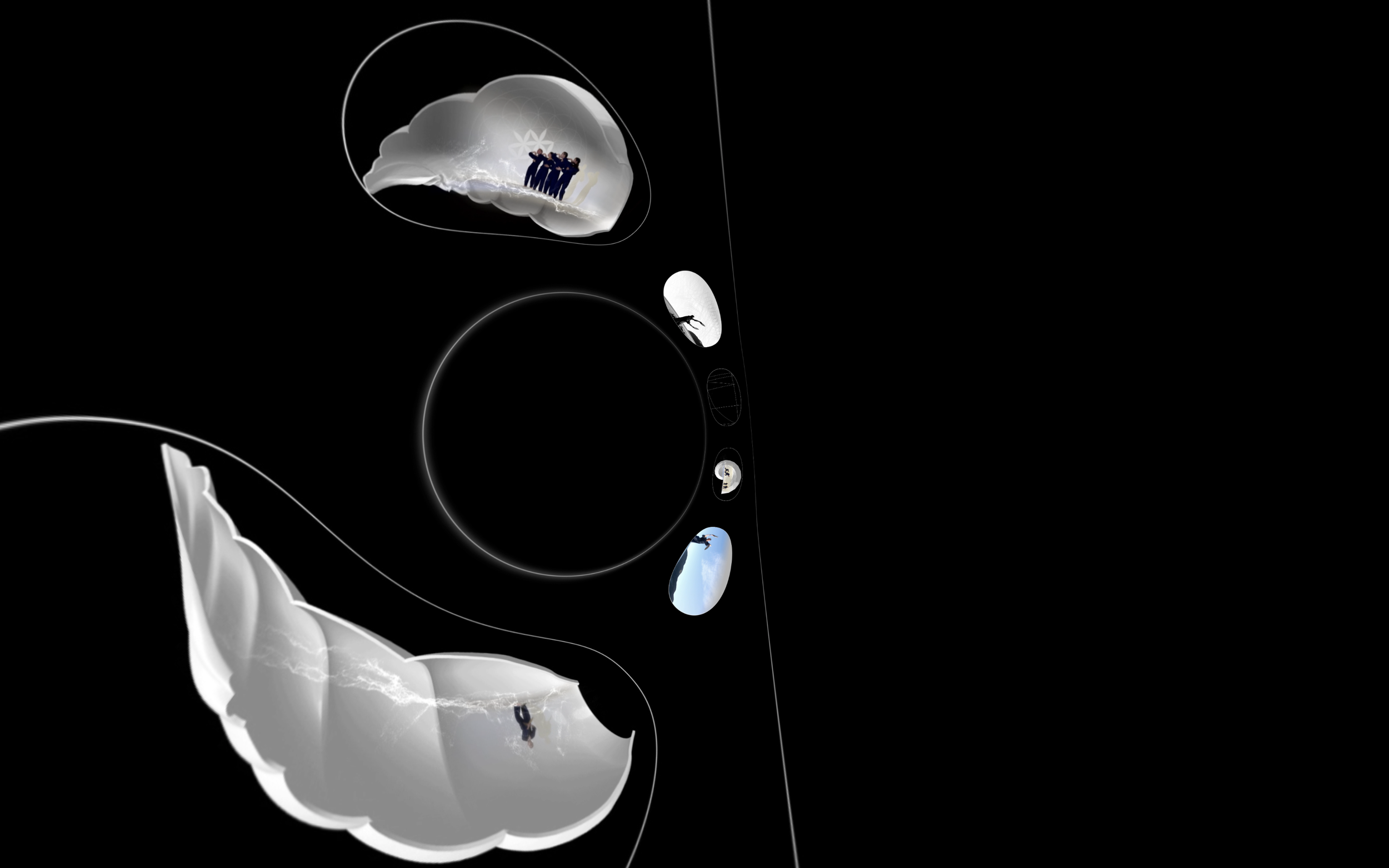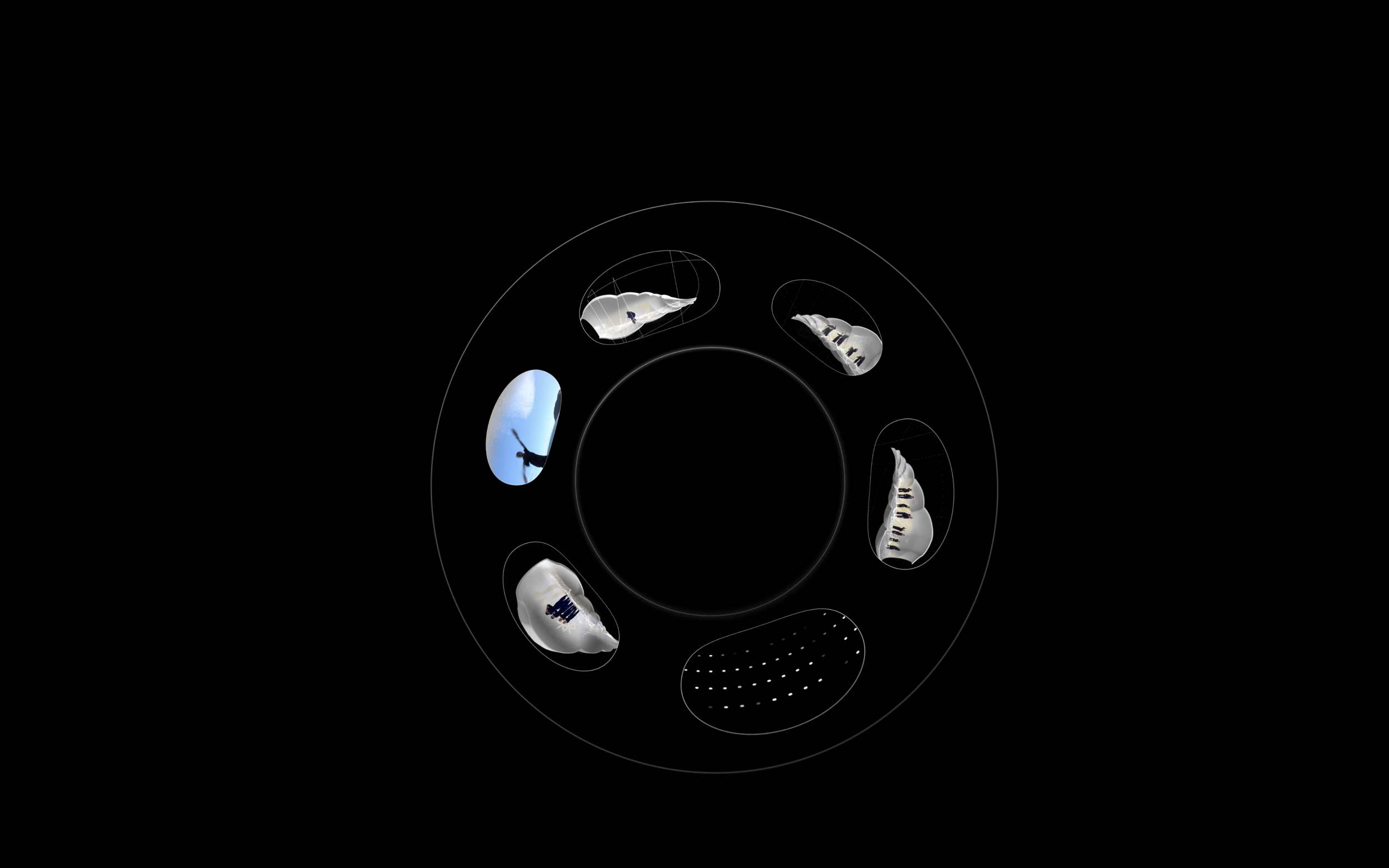NAUTILUS
Pōtaka Nautilus is a multi-modal project. Digital film fragments act as conduits for stories in dance, sound, and light. Spatially augmented journeys emanate from the screen as miniature cinematic poems supported by taonga pūoro (traditional Māori instruments), sampled cello and electronics. Woven and digital representations evoke concepts of shelter, navigation and travel. The spiral is one of our most ancient and enigmatic symbols. Images of galaxies show the spiral in myriad continuous expansions towards the infinite. In nature, spirals are everywhere, from shells to the movement of electrons, from fingerprints to the shape of hurricanes, from the vortex of a whirlpool to the flight of birds of prey. The spiral is an age-old intuitive symbol of spiritual development and our identity with the universe. Spirals often appear engraved on the stone of the monuments that were illuminated during the solstice and the equinox. This primordial symbol unites cultures and peoples all over the world, from the Northern Europe of the ancient Celts to South America, from Africa to the Mediterranean and throughout Asia and the Pacific.
Concentric rings of the spiral expanding from a central point are a symbol of growth and rebirth; a feminine symbol linking to the generative force of the universe and to the mystery of birth. The koru, used in Māori art, is based on the shape of an unfurling fern frond. Spirals convey perpetual movement with the coil suggesting a return to the point of origin. The spiral and the koru signal identity with the universe and demonstrate the evolutionary nature of the journey. Pōtaka tā are spinning tops that revolve in a vertical direction, a process called precession. As the spin of the top slows, we see this precession become faster, and then begin to bob up and down as it precesses further - the rotation is all centred on the spiral.
In Pōtaka Nautilus the shell is representative of a haven, a refuge space. This project offers a mosaic of dance, sound and light that can be seen as portals of time through multiple lenses. Audiences are transported into a world suspended between timelessness and the here and now. Digital dancers appear cocooned by oscillating ovoid forms - opening and closing as dimensional thresholds.
Traditional Māori raranga weaving (with harakeke or flax), and Māori musical instruments form significant parts of the creative dialogue that connect us to natural elements such as earth and water, air and sunlight. This project binds together the energy of filmed dance performance with digital media, and offers a virtual kaleidoscope of solos, duos quartets and octets in dance. Digital sound shells carry the dancers as virtual stages, gliding through space, navigating coastal zones of Aotearoa New Zealand. The pūpū harakeke (flax snail shell) is played by taonga pūoro artists as a flute. This shell form is represented in our film design to evoke travel and navigation (a waka or ship), a wharenui or sanctuary, and as portals. Kōauau pūpū harakeke and pūtātara (trumpet) shell timbres heard in the soundscape are emotional. Taonga pūoro connects us to bodies of land and water, to breath and dance, to signify transience within the natural world. Everything is movement. Thich Nhat Hahn said that the real insight of inter-being was to see humanity as part of Earth, that we are part of the planet. To see beyond the illusion of separateness, we must comprehend that Papatūānuku (Mother Earth) is not just our environment. Our DNA is galactic, we carry Papatūānuku within us. Knowledge our ancestors possessed was very different to what we know about our world today. We dream, we create ideologies and systems - this project looks at our will to survive, to be integral.
Pōtaka Nautilus is constructed from moments syncopating and retuning as a series of pulses. Very slow passages feel almost glacial in their momentum. The seed of movement resides within stillness as a fundamental potential. The mountains of Te Wai Pounamu (South Island of Aotearoa New Zealand) can be seen in the distance across the sea. Dance, visuals and sound combine to glimpse the human being in motion as part of an eternal cycle. As if reaching into the fibres of space - Pōtaka Nautilus pictures a living breathing cosmos, elevated by the shared breath of dance and the sound of taonga pūoro.
Heartfelt thanks to Patxi Araujo of La Universidad del País Vasco/Euskal Herriko Unibertsitatea. Acknowledgements and thanks to Festival After Cage 2023, ASOCIACIÓN E 7.2, and Museo de Navarra, Pamplona, Spain. Special thanks to the College of Creative Arts Toi Rauwhārangi, Massey University Te Kunenga ki Pūrehuroa, the NZPQ23 Ka emiemi team, and The Arts Centre Te Matatiki Toi Ora, Ōtautahi, Christchurch, New Zealand (Matariki 2024 Festival). Ngā mihi nui Creative New Zealand toi Aotearoa for supporting the realisation and sharing of this collaboration including our interactive exhibition in Osaka, Japan during October 2024, and in 2025 with the evolution of this project as live performance double bill alongside PEPE for Dunedin Arts Festival - featuring taonga pūoro master artists Ariana Tikao, Mahina Kingi-Kaui, Alistair Fraser and Dr Ruby Solly activating large format live keyed film projections.
Daniel Belton and Good Company Arts
NAUTILUS VR EXPERIENCE
360 VR Movie - Can be played on Desktop browser or with the Vimeo mobile app. Winner Best VR Experience Seoul International Short Film Festival 2024.























